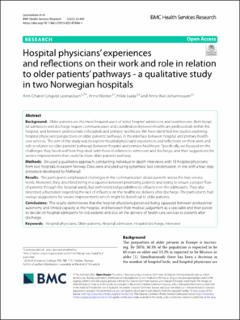| dc.contributor.author | Leonardsen, Ann-Chatrin Linqvist | |
| dc.contributor.author | Werner, Anne | |
| dc.contributor.author | Lurås, Hilde | |
| dc.contributor.author | Johannessen, Anne-Kari | |
| dc.date.accessioned | 2023-02-06T11:45:13Z | |
| dc.date.available | 2023-02-06T11:45:13Z | |
| dc.date.created | 2022-03-24T12:39:08Z | |
| dc.date.issued | 2022 | |
| dc.identifier.citation | BMC Health Services Research. 2022, 22, Artikkel 443. | en_US |
| dc.identifier.issn | 1472-6963 | |
| dc.identifier.uri | https://hdl.handle.net/11250/3048543 | |
| dc.description.abstract | Background: Older patients are the most frequent users of initial hospital admissions and readmissions. Both hosptal admission and discharge require communication and coordination between healthcare professionals within the hospital, and between professionals in hospitals and primary healthcare. We have identifed few studies exploring hospital physicians’ perspectives on older patients’ pathways in the interface between hospital and primary healthcare services. The aim of this study was to explore hospital physicians’ experiences and refections on their work and role in relation to older patients’ pathways between hospital and primary healthcare. Specifcally, we focused on the challenges they faced and how they dealt with these in relation to admission and discharge, and their suggestions for service improvements that could facilitate older patients’ pathway.
Methods: We used a qualitative approach, conducting individual in-depth interviews with 18 hospital physicians from two hospitals in eastern Norway. Data were analyzed using systematic text condensation, in line with a four-step prosedure developed by Malterud.
Results: The participants emphasized challenges in the communication about patients across the two service levels. Moreover, they described being in a squeeze between prioritizing patients and trying to ensure a proper fow of patients through the hospital wards, but with restricted possibilities to infuence on the admissions. They also described a frustration regarding the lack of infuence on the healthcare delivery after discharge. The participants had various suggestions for service improvements which might be benefcial to older patients.
Conclusions: The results demonstrate that the hospital physicians perceived being squeezed between professional autonomy and limited capacity at the hospital, and between their medical judgement as a specialist and their power to decide on hospital admissions for old patients and also on the delivery of health care services to patients after discharge. | en_US |
| dc.language.iso | eng | en_US |
| dc.publisher | Springer Nature | en_US |
| dc.rights | Navngivelse 4.0 Internasjonal | * |
| dc.rights.uri | http://creativecommons.org/licenses/by/4.0/deed.no | * |
| dc.subject | hospital physicians | en_US |
| dc.subject | older patients | en_US |
| dc.subject | hospital admission | en_US |
| dc.subject | hospital discharge | en_US |
| dc.subject | interview | en_US |
| dc.title | Hospital physicians’ experiences and reflections on their work and role in relation to older patients’ pathways - a qualitative study in two Norwegian hospitals | en_US |
| dc.type | Peer reviewed | en_US |
| dc.type | Journal article | en_US |
| dc.description.version | publishedVersion | en_US |
| dc.rights.holder | © The Author(s) 2022. | en_US |
| dc.subject.nsi | VDP::Medisinske Fag: 700::Klinisk medisinske fag: 750::Geriatri: 778 | en_US |
| dc.source.volume | 22 | en_US |
| dc.source.journal | BMC Health Services Research | en_US |
| dc.identifier.doi | 10.1186/s12913-022-07846-1 | |
| dc.identifier.cristin | 2012257 | |
| dc.source.articlenumber | 443 | en_US |
| cristin.ispublished | true | |
| cristin.fulltext | original | |
| cristin.qualitycode | 2 | |

